Medium voltage systems are defined by the IEEE as those operating at voltage levels greater than 1,000 volts and up to 72,000 volts. High voltage is defined by NEC 490.2 as any system operating at “more than 600 volts, nominal.”
Field electrical inspectors may be asked to inspect medium voltage installations in the course of their duties, but some may feel unqualified or overwhelmed at the thought of inspecting these installations because their work experience has been more residential and commercial construction, and they have little or no medium voltage experience. This article will be useful as a start to the education process. It is not comprehensive but rather a guide to assist those who may be new to inspecting medium voltage installations up to 15,000 volts. Code sections and basic requirements will be provided for a typical scenario of a customer-owned system consisting of a service disconnect on the property, an underground feeder to a primary transformer, and underground raceways and cables installed into switchgear or a unit substation.

Photo 1. Medium voltage switchgear (motor control center)
Many industrial plants, universities, medical facilities, and high-rise buildings are served by medium voltage electrical distribution systems. In the past 20–30 years, there has been a proliferation of customer-owned medium voltage distribution systems in North America. Prior to that, with few exceptions, electric utilities owned these systems. As with many changes, cost savings are a factor. As all businesses seek to operate more efficiently and cut costs, incentives may be offered to large power users who own the entire electrical distribution system on their property, including all power distribution systems operating at over 600 volts. Reduced power rates are made available via primary metering, which is when the electric utility sells the utility-owned medium voltage power system on the customer’s property to the customer, meters the power at a higher voltage and reduced rate, and is no longer responsible for maintenance of the equipment. This saves the utility labor and material costs. The customer becomes responsible for all upkeep and repairs of the equipment, conductors, poles, and structures. Code-compliance is required per NEC 90.2(A) when a new system is installed or when an existing system taken over from the utility is altered or upgraded.
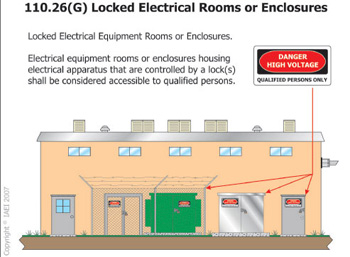
Figure 1. Locked electrical rooms or enclosures
Existing electric utility installations often vary widely from the NEC. In most cases, the installation was completed many years, if not decades, earlier and was designed under utility engineering supervision and not required to meet any requirements of theNECat the time. If the installation is unaltered, it is often permitted to remain as is by inspection authorities unless someone notices a severe hazard, because it was installed by qualified persons and generally with engineering supervision. On the other hand, adverse changes to the electrical system may have come about by walls, fences or structures being built that impinge on working clearance, accidental damage to the installation, deterioration by weather or lack of maintenance, or by an unsafe modification of the original installation. If this is the case, the new owner has the choice of repairing the existing system or installing a new medium voltage system.
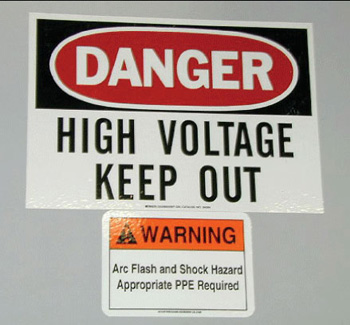
Photo 2. Permanent and conspicuous warning signs per 110.34(C)
Most jurisdictions and their inspection staff will face this situation eventually. The question is, how do you handle the inspection of a new installation or an existing medium voltage system that is being modified? How far do you go to bring the work up to Code? A field visit to the site by the electrical inspector, along with the customer, engineer, contractor, and supplying utility representatives may be in order. No commitments need to be made at this point, as the meeting is strictly to gather information for further study before plans are drawn. Clear communication of the proposed changes and improvements and the interests of all involved is a great place to start. Making the call on how far to go in requiring existing installations to be improved must be handled on a case-by-case basis. Naturally, customers are concerned about the cost of correcting existing situations. It is best for inspection authorities to focus on any inherent good in the installation that would allow it to remain, at least in part if possible. Many believe that focusing on the main points of what is really needed to make the existing installation safe and trying not to re-invent the wheel can be helpful at this point.
From that perspective, here are some inspection points to be considered.
Review Plans and System
The first step in any inspection is a thorough review of both the plans and the system itself. Typically, with a new or altered installation, an engineered plan set is required to be drawn and stamped by the design electrical engineer, and a plan review performed by the inspection jurisdiction. After an onsite meeting and plan review, the approved plan set should be placed on the job and available for the field inspector to verify that the installation was performed according to the approved plans.
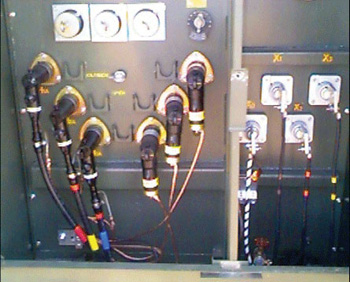
Photo 3. Cables with load break elbows
Before the inspection begins, it is important for the field inspector to know the system voltage and to ensure that the system is de-energized. Generally, the inspector should put away his or her tools and not open doors on equipment or enclosures unless he is qualified by experience and safety training on the equipment; instead, he should wait for the installing contractor or electrician to open them. He should know when and what types of PPE is required, use it, and follow all safety rules. This caution cannot be over-emphasized; otherwise, his safety and that of others could be at risk.
In addition, the inspector needs to know what the power source is and where it is located. If a new or altered service, where is the service point?
Listed parts usually are not required on utility systems built under the supervision of a professional engineer. However, most local or state electrical ordinances require listing of conductors, raceways and equipment. Listed equipment may not be available for some medium voltage systems, and a field evaluation may need to be considered.
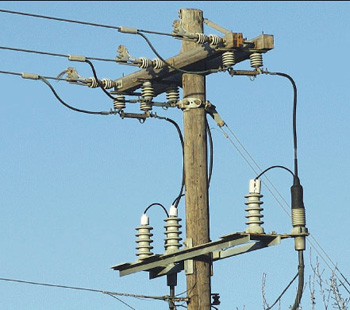
Photo 4. Solid-blade disconnect switches could be used to disconnect the transformer.
If new equipment is being installed, all information found in the manufacturer’s installation instructions must be available for the field inspector, who should verify that these instructions have been followed. [NEC110.3(B). Installation and Use]. Information is often not available for existing systems taken over from a utility. Remember that all requirements provided inNEC110.1 through 110.22 apply to medium-voltage electrical systems covered byNEC110.30.
Other essential questions are, Will qualified persons service the installation? Does the inspection agency require documented proof of safety training to meet the Code requirements of being a qualified person? (NEC Article 100).
Is there a request asking that the installation be considered as a “supervised installation,” or is “special permission” for the work being requested of the AHJ?
Required Testing and Calculations
Remember that all “completed wiring installations shall be free of short circuits, ground faults…” as found in Section 110.7. Testing is required and must be verified by documentation. Medium voltage electrical equipment typically has been tested at the factory; however, field testing is also required because improper installation, or damage to equipment or materials that occurred during shipment or installation may be missed by a visual inspection. A hi-pot test should be conducted and verified to the inspector’s satisfaction. The author is aware of installations outside his jurisdiction which were hurried to meet a timeframe and were not tested in the field, but which later exploded and caught fire when energized. The customer paying for the work was certainly impressed! This type of impression any electrical installer can do without.
A good reminder for installers of any type of electrical installation is to double-check their own work after completing it, and to test equipment if required by NETA guidelines before calling for an inspection. Incorporating these simple habits saves time and money, red-tags, call backs, unhappy customers, and certainly pays for itself. It also saves embarrassing and costly moments.
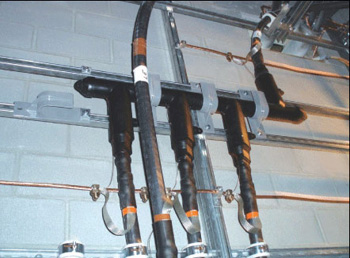
Photo 5. Medium voltage cable supports
A thorough and thoughtful visual inspection is advised. The author inspected a unit substation at a regional medical facility (12,470-volt fused switch and power transformer with a 480Y/277-volt secondary in the same piece of equipment) where a close visual inspection found that one of the high-voltage phase terminations to the transformer was completely broken and separated at the connection. The electrical contractor was unaware of the condition. Repairs were made, the installation was hi-potted and approved.
Another important consideration is the available fault current at all points of the system. What are the AIC ratings of the equipment and the impedance of the transformer(s)? This information should be included in the approved plans, and field-verified to see that the installed equipment, conductors, transformers, overcurrent protection, etc., match what was approved. The fault-current rating of the equipment must be checked (NEC 110.9, 110.10). A load calculation should also be included in the plans and verified.
Required Working Clearance, Warning Labels, and Workmanship
When approaching the site, whether an indoor or outdoor installation, one should review the minimum safe working clearance requirements found in NEC 110.33. Spaces above, around and behind equipment must be surveyed. The inspector should investigate access to and egress from electrical equipment, such as switchgear, transformers, fusible disconnects, etc., that may require work to be done on it while it is energized, as well as personnel doors within 25 feet of the working space. (NEC 110.34).
Are locked enclosures accessible only to qualified persons? Are special written procedures required? Is sign-age stating “DANGER – HIGH VOLTAGE – KEEP OUT” posted where required? Is illumination present? [NEC 110.34 (A) through (D)].
A question often arises regarding dry-type transformers. Working clearance in front of these transformers may be required if work, such as an infrared scan for maintenance purposes, is done while equipment is energized. Ventilation clearances are also required and must be checked.
Article 490 Part III includes requirements for enclosures. Enclosures may be located indoors, in damp or wet locations, or where exposed to extreme temperatures or effects from weather. Most new electrical equipment such as switchgear encloses any live parts. Switchgear that contains exposed live parts must be located in a permanently dry environment where competent supervision is onsite, and be accessible only to qualified persons. It is advised that switchgear be located so that any possible damage is reduced to a minimum, and not be located adjacent to easily combustible material, and if installed over a wood floor, a closed bottom is recommended for fire prevention reasons.

Photo 6. Underground cable and shields neatly installed. These need protection from abrasion with conduit fitting, and raceway sealed.
Be sure to verify that the doors, windows, hinges, and hardware are properly installed. [NEC 110.12, 110.3(B), 490.38]. Are all bolts and fasteners in place and tight? Are doorstops in place for hinged doors? What about busbars? Are all bolts/Belleville washers and nuts in busbars secured and properly tightened?NEC490.32 requires barriers to be installed, if needed, so that no uninsulated ungrounded service busbar or terminal is exposed to accidental contact by persons working on the equipment. Section 490.33 requires that energized bare parts on doors be guarded where the door must be opened for maintenance, etc. Is the equipment properly mounted and secured to the mounting surface (NEC110.13), and located so that proper cooling is maintained? Transformers installed too close to building surfaces or other electrical equipment can be a fire hazard and/or impede cooling.
Was the work performed in a workmanlike manner? (NEC110.12) Are there any unused openings in the front, sides, top or bottom of the equipment? Is the integrity of the equipment, cables, and connections solid and correct? Is any moisture, dust, dirt, deteriorating agent, conductive compound or cleaner removed? (NEC110.11). Are there any tools, such as screwdrivers, wrenches, etc., left inside the equipment? Are load break elbows properly installed, grounded and parked? Are all other conductors properly terminated? (NEC110.14, 110.40)
Medium Voltage Services and Switchgear
If the installation is an electrical service, it must comply with all previous sections of Article 230, Over 600 Volts, which may be supplemented or modified by Part VII of the article.
Service conductors are generally not permitted to be smaller than 6 AWG; however, in multi-conductor cable, 8 AWG is permitted.
Where is the service disconnecting means located—at the property line or elsewhere on the property? Switches may be the overhead gangable switch type with fused cutouts or an underground fed switchgear cabinet. Others may be installed in a substation type arrangement, fenced in, with a transformer and bus structure. Perhaps the existing installation has singly operated fused cutouts, one per phase. TheCodegenerally requires that a disconnecting means “simultaneously disconnect all ungrounded service conductors” per 230.205(B); if and when the installation is altered, this should be required. A change inNEC-2008, Section 230.205(A) permits the disconnect to be placed in a location that is not readily accessible. There are a growing number of installations where the customer service point and service disconnect are located at the property line, and one or more medium voltage feeders traverse the property to the step-down transformer and distribution equipment.NEC230.208(B) states that overcurrent devices supplying continuous loads are not restricted to 80% load rating for systems operating at over 600 volts. In other words, a 90-ampere continuous load could be protected by a 100-ampere-rated overcurrent protective device.
Requirements for overcurrent protection are provided inNEC240.100(1). Overcurrent relays and current transformers with an overcurrent relay element operated by a current transformer for each phase, or a fuse in series with each phase conductor is one type of protection scheme. Protective devices must be capable of detecting and interrupting all values of current that exceed the device trip setting or melting point. For feeder and branch circuits, the continuous rating of a fuse shall not exceed three times the ampacity of the conductors. The longtime trip setting of a circuit breaker or minimum setting of an electronically actuated fuse may not exceed six times the rated ampacity of the conductors. Remember that systems over 600 volts have feeders or branch circuits, too.
Overcurrent protective devices must meet the requirements of Sections 230.206 and 208, and 240.100 or 240.101. Most of these installations are feeders that permit a maximum three times the conductor ampacity if a fuse were used, and six times for a circuit breaker.
Section 490.24 gives requirements for minimum clearances from exposed live parts.
Grounding and Neutral Conductors
Grounding is imperative! The inspector must ensure that all metal bus structures, poles, fences or other metal enclosures, rotating or otherwise operable switch arms, metal lids and covers on underground pull/junction boxes, door frames, grids, or metal support structures for racked cables are all properly grounded and bonded using one of the conductor termination methods specified in NEC 250.8, and sized per Tables 250.66 or 250.122 as appropriate (see Section 250.180). Equipment grounding conductors that are not an integral part of a cable assembly are required to be not smaller than 6 AWG copper or 4 AWG aluminum (250.190). Sometimes these bonding conductors to fences or gates, for instance, have been damaged, disconnected, or stolen.
If switchgear is used as service equipment, a main bonding jumper sized per 250.28(D) must be installed, and all sections of the gear bonded together per 250.66 or 250.122 as applicable; and all cable shields and grounding electrode conductors terminated in the equipment. Remember that medium voltage systems must comply with Section 250.180, which states that all requirements for grounding and bonding of systems in Parts I through IX of Article 250 apply to 1,000-volt systems and over, except as modified by Part X of Article 250. Therefore, Tables 250.66 and 250.122, for example, apply to these systems as minimum sizes for grounding conductors.
Per Section 250.184(A)(1), all neutral conductors must generally have a 600-volt minimum insulation level. Bare conductors are permitted for service entrance, service laterals, or direct-buried feeders in some instances [250.184(A)]. The neutral conductor must be sized for the load, but no smaller than 33-1/3% of the phase conductors; except that industrial and commercial premises under engineering supervision are permitted to have neutral conductors rated only 20% of the phase conductors.
Cables
Moving on to cables for new installations, Section 310.6 generally requires insulated cables operating above 2000 volts in permanent installations to have ozone-resistant insulation and to be shielded. The metallic shields must be grounded to the grounding electrode conductor, grounding busbar, or a grounding electrode. Section 310.7 generally requires direct-buried cables operating above 2,000 volts to be shielded.
Are the cables listed for the use? It is not uncommon to find unlisted cables in existing installations, because listing was not required when the cable was installed. Most inspection jurisdictions will require listing of the cables and equipment and, though not specifically required in theNEC, some type of tag to identify each cable specifically for its phase, feeder, and the circuit it powers, etc.
Most new installations incorporate the use of Type MV medium voltage cable (Types MV-90 or MV-105). Listed MV cable is widely available and, when properly selected and installed, is generally accepted by AHJs. These cables are rated from 2,001 to 35,000 volts and, depending upon the manufacturer and listing of the cable in question, are permitted in wet or dry locations, in raceways, in cable trays, direct-buried, as messenger-supported wiring, or as exposed runs per 300.37. This is not an all-inclusive list. Type MV cable is not permitted in direct sunlight unless identified for the use. These newer cables will be well marked (310.11) and easier to identify for proper installation and use. [(110.3(B)].
NEC300.34 gives minimum conductor bending radius requirements during and after installation—8 times the overall diameter for non-shielded conductors or 12 times the overall diameter for shielded conductors. The same section provides requirements for multi-conductor cable operating at over 600 volts. Section 310.11 contains marking requirements for cable type, voltage rating, AWG, manufacturer’s name, etc. Tables 310.13(B) and (C) provide insulation thickness ratings, and Tables 310.67 through 86 provide ampacities for a variety of MV cables and installations.
Underground Cables and Raceways
Section 300.50(A) provides requirements for unshielded cables installed underground, which must be installed in RMC, IMC, or PVC conduit encased in 3” of concrete. Section 300.50(B) requires conductors emerging from the earth to be encased in listed raceways consisting of RMC, IMC, Schedule 80 PVC or equivalent, which extend from the minimum cover depth to a minimum height of 8 feet above finished grade. Conductors entering a building or structure must be completely protected by an approved enclosure or raceway, and metal raceways must be grounded. Protection from frost heaves or movement must be provided for direct-buried cables in cold climates where the situation and climate dictate.
Underground splices in cables are permitted with or without junction boxes, provided materials suitable to the application are used, the splices or taps are watertight, and the conductors are protected from mechanical damage. Where shielded cables are spliced, the shields must be properly spliced together and continued across the tap or splice.
Are the cables listed for underground installation—direct burial—or installed in a raceway? Proper raceway preparation requires that the raceway be swabbed or cleaned to remove any possible debris before installing the cable(s). NEC 300.50 addresses direct-buried cable depth and the depth for cables installed in a raceway. Is the underground installation protected by concrete cover or encasement, or by burial at a proper depth and with warning tape installed 12″” above the buried cable? Backfill must not contain large rocks, cinders, paving material, large or sharply angled substances, or corrosive materials. Soft material such as sand bedding is commonly used to protect the cable from physical damage.
Section 300.50(E) requires raceways entering a building or electrical equipment to be sealed with an identified sealing compound in order to prevent the entrance of moisture or gases, which can travel through raceway systems, and to be arranged to prevent moisture from contacting live parts. Section 310.60 and Figure 310.60 in theNECmust be consulted regarding burial depth and related ampacity of conductors; requirements for cables installed in electrical ducts (conduits) or duct banks underground or embedded in concrete; and required spacing of ducts, and/or ampacity adjustments for various depths of installations.
Circuits Identified
It is important for safety that all circuits be clearly marked.NEC110.22 requires a circuit to be correctly identified for the use, and “legibly identified for its clear, evident, and specific purpose or use…easily distinguished from all others. Spare positions that contain unused overcurrent devices or switches shall be described accordingly.”
Transformers
Finally, transformers are the heart of the system and require overcurrent protection per Section and Table 450.3(A). Physical protection and ventilation are required per 450.8 and 450.9. Grounding is required per 450.10, 250.180, 250.184, 250.66, and 250.122. Transformer installations must be accessible to qualified persons per 450.13.
Again, this article is not by any means comprehensive, but is a merely a starting point for inspections of medium voltage systems. We have given a broad overview of solidly grounded medium voltage systems and typical scenarios of customer-owned systems. There is much more to know and understand about these installations, but each journey begins with a first step.











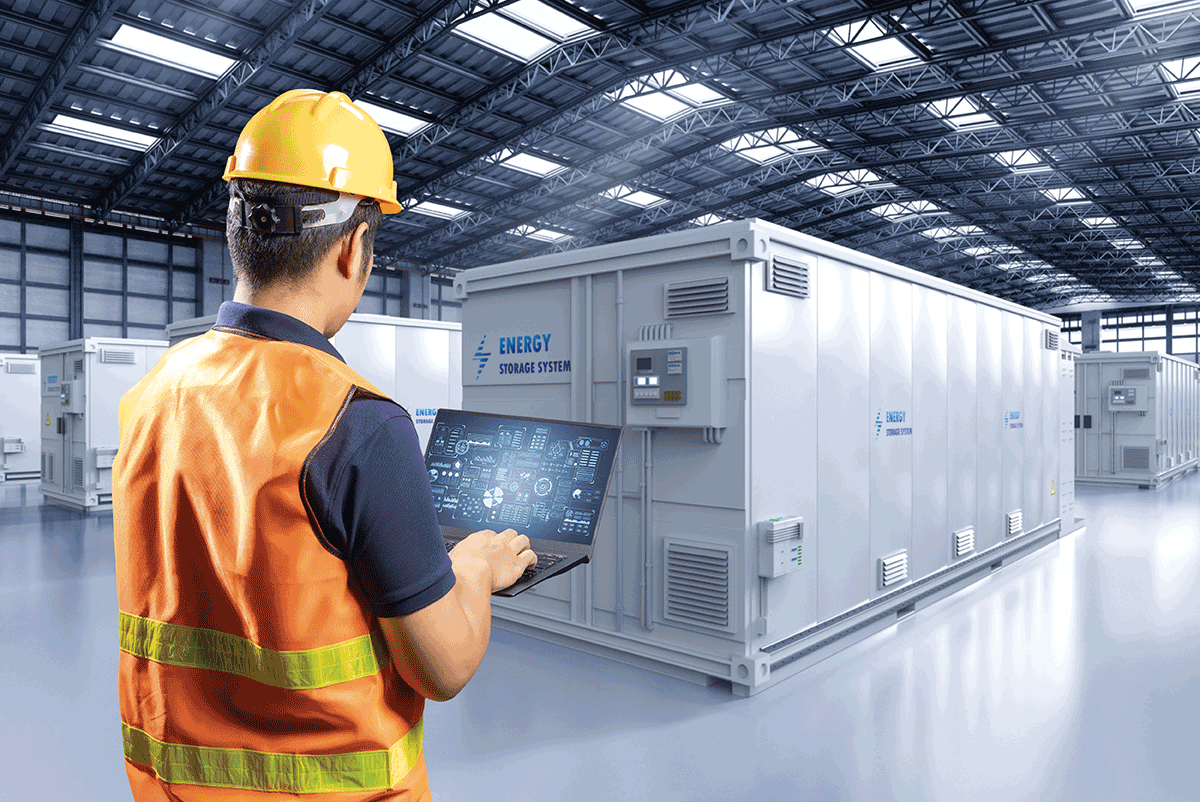

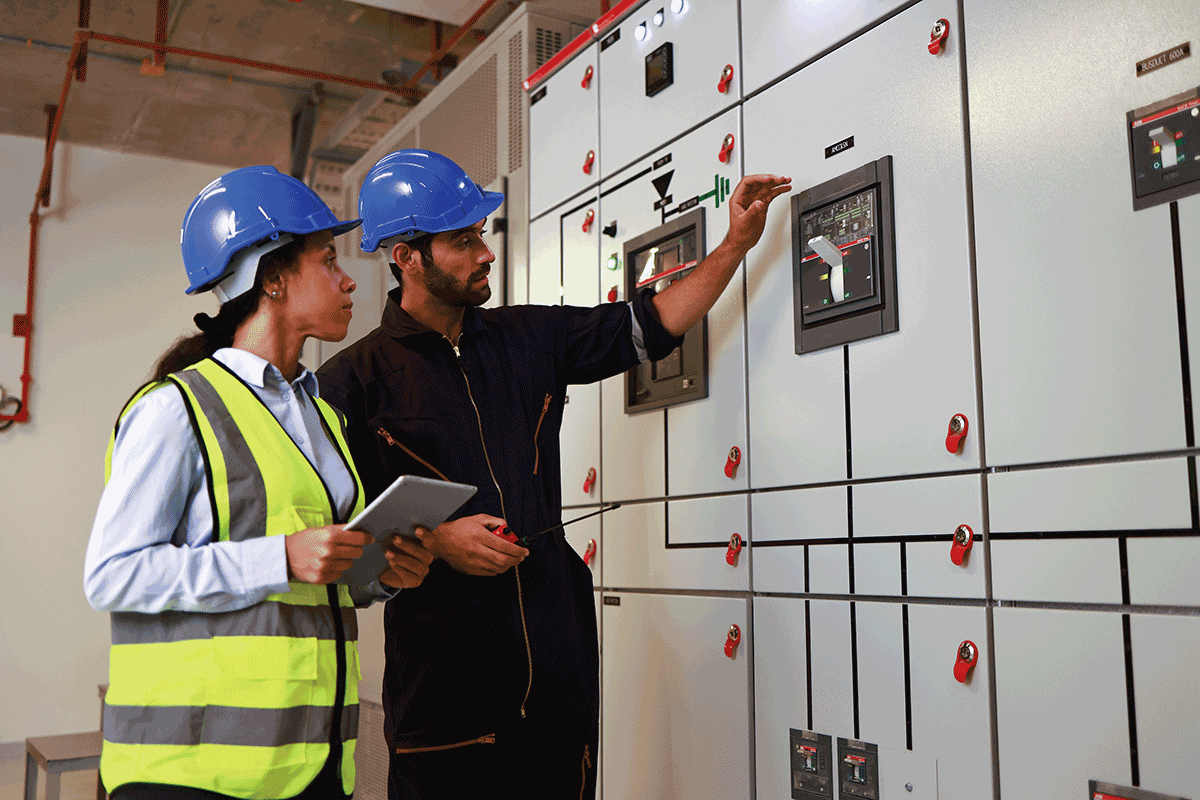
Find Us on Socials